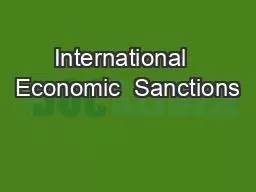

Modeling Morad BALI Natalia BOUROVA Nady RAPELANORO Introduction Definitions Measures raised by a constitutional authorized entity in order to constraints a target ID: 796318
Download The PPT/PDF document "International Economic Sanctions" is the property of its rightful owner. Permission is granted to download and print the materials on this web site for personal, non-commercial use only, and to display it on your personal computer provided you do not modify the materials and that you retain all copyright notices contained in the materials. By downloading content from our website, you accept the terms of this agreement.
Slide1
International Economic Sanctions Modeling
Morad BALI, Natalia BOUROVA, Nady RAPELANORO
Slide2Introduction
Definitions
Measures
raised
by a
constitutional
authorized
entity
, in
order
to
constraints
a
target
country to change
his
policies
, in a
way
that
they
are not
against
international
law
anymore
.
Doxey
(1971)
A
kind
of
coercive
diplomatic
measure
that
can
be
defined
as the
fact
to
inflict
an
economic
pressure to a country, in
order
to
demonstrate
a
will
to
protect
predefined
interests
,
while
keeping
the
ability
to
start
a
military
intervention if
it
is
necessary
.
George, Hall, and
Simons
(1971)
Literature
Doxey
(1971
)
: a
pioneer
, one of the first to have
started
econometric
work
on sanctions.
Hufbauer
, Schott,
and
Elliott (1990
)
: a
key
reference
as
they
studied
one
century
of
sanctions
.
Dreger
,
Fidrmuc
,
Kholodilin
, and Ulbricht (2015
)
: the first to
introduce
a sanction index to
simulate
sanctions.
Why
a good sanctions index
is
important ? To
simulate
sanctions
arrival
, to
avoid
the use of
dummy
variables (
less
accurate
), to use
Vector
Autoregressive
models
(VAR), to
forecast
.
Slide3Old Index
Dreger
, et al. (
2015
)
created
a sanction index
with
the
following
characteristics
:
A
composite index
with
values of
either
:
0 : no sanctions
1 :
against
individuals
2 :
against
specific
entities
3 :
against
an
entire
economic
sector
A
weight
depending
of the
trade
relationship
between
the
target
and the
sender
. The
stronger
their
relationship
is
, the
higher
the
weight
of sanctions
will
be
.
This index
was
extended
and
used
more
recently
by
Kholodilin
and
Netsunajev
(2016
).
Slide4Old Index - Limitations
Kholodilin and
Netsunajev (2016)
-
Only three types of sanctions. That are not proportional :
a sanction against an entire sector is only three times stronger than a sanction against one individual !
-
It grows with the arrival of new sanctions, but can’t decrease :
It means that sanctions decided in 2014, will still have the same effects in 2018.
-
Sanctions are not treated independently from each other :
impossible to know if the effects are due to American or European sanctions, for example
-Index is quarterly only.
Slide5New Sanction Index
Still
a composite index, but more
developed
.
Each
sanction has
its
own ID, including :
Sender country :
which
country set up
this
sanction ?
The initial value
determined
by :
Type of sanction :
announcement
,
against
individual
,
company
,
sectors
.
Three
coefficients
affecting
its
value
Time factor :
g
athers
all
inexplicable factors that have a negative effect on the economic pressure induced by punitive measures.
Economic leverage
: the ability of the sender to apply economic pressure on the target (if the country doesn’t trade at all with the target, the leverage is nil.
Third country effect
: the presence of a third country, helping the target to avoid sanctions.
Slide6New Sanction Index
Slide7New Sanction Index
Sanction against
Dummy variable’s value
0
Individual
1
10
A company
100
An economic sector
1000
An embargo
3000
Initial value, depending on the type of sanction :
Slide8New Sanction Index
-The Index is monthly and can be turned in quarterly.
-Each sanction is independent and can be modified without influencing others.
-Sanctions ability to create economic pressure decrease over time.
- Sanctions types and
attributed values are more realistic. Even though it remains an heuristic.
Slide9Results improvements - illustration
Two Structural VAR models,
built in the same way
. The
only
variable that differs is the
sanction index
.
The Confidence Interval is tightened with the new index : results are statistically more significant.
Better explanatory power:
on the left we can explain 0.7% of the variation of our interest variable,
while on the right –with the new index- we can explain 4.8%.
With the OLD Index
With the New Index
Slide10Thank you for your attention
Don’t
hesitate
to contact us if
you
have
precise
questions, or if you wish to have access
to
our
sanction index.
Bali, M. :
PhD
student
and Researcher in International
Economics
. Theorist of the New Sanction Index. moradbalifr@gmail.comBourova, N. : Professor and Researcher – Director of the French-Russian Center for Educational and Scientific Cooperation of SPbGEU. Research Supervisor.nbourova@mail.ruRapelanoro, N. Doctor in Economics and Researcher in Econometrics. Main Econometrician. nady.rapelanoro@gmail.com